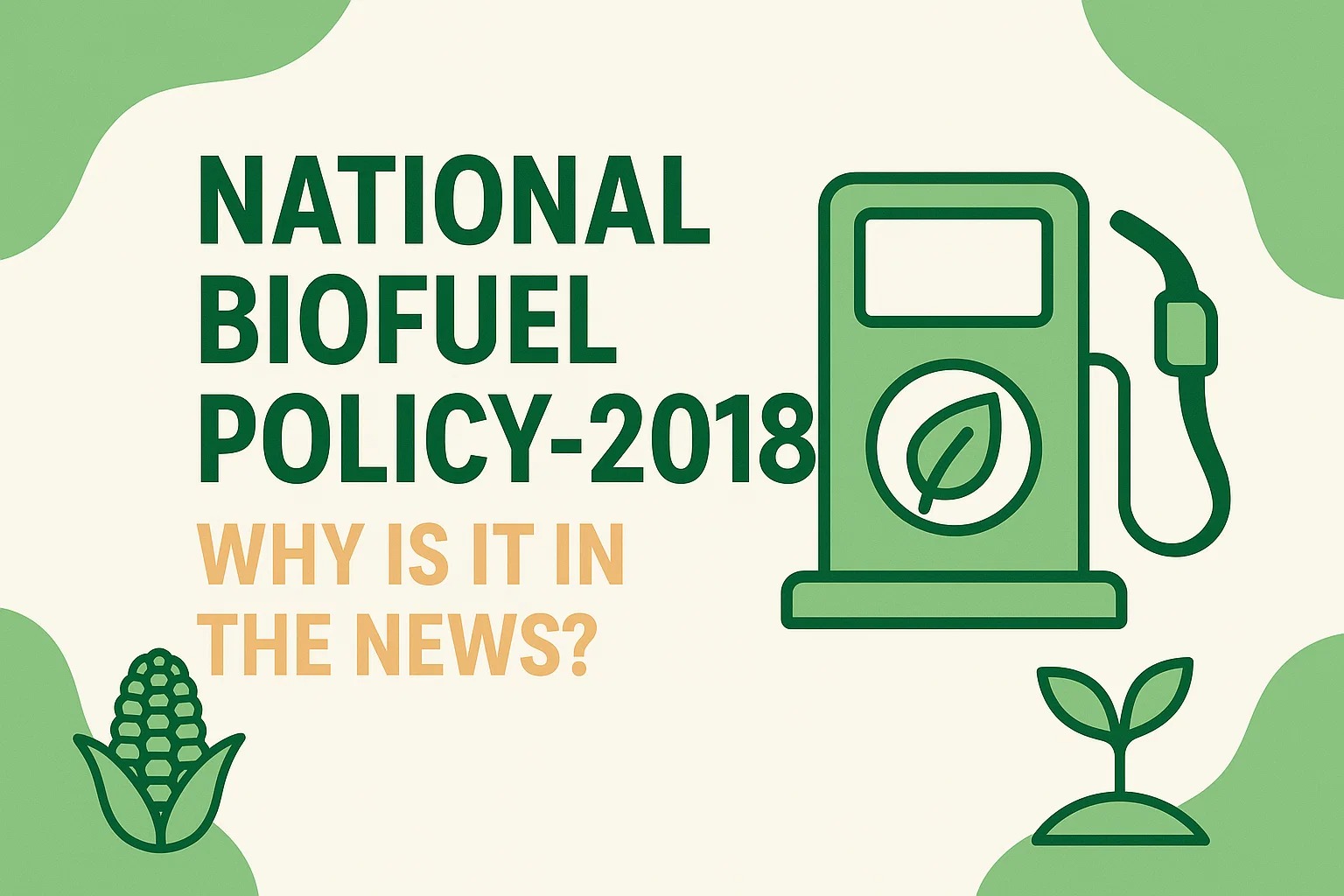There are no items in your cart
Add More
Add More
| Item Details | Price | ||
|---|---|---|---|
Why Is It in the News?
India has begun the nationwide rollout of E20 petrol, a fuel blend containing 20% ethanol and 80% petrol, five years ahead of its original 2030 target. This is part of the government’s push for cleaner fuels under the National Policy on Biofuels, 2018. However, the move has sparked public backlash due to reduced fuel efficiency, engine compatibility issues, and lack of consumer choice in many regions. The development puts a spotlight on India’s biofuel strategy and energy transition efforts. 
What Are Biofuels?
Biofuels are fuels derived from biomass—plant material, agricultural waste, or animal waste—used as a renewable alternative to fossil fuels.
Types of Biofuels:
| Generation | Feedstock Source | Examples |
| 1st Gen | Food crops (sugarcane, corn, vegetable oil) Ethanol | Biodiesel |
| 2nd Gen | Non-food crops & agri waste | Cellulosic ethanol |
| 3rd Gen | Algae and microbes | Algae-based biodiesel |
| 4th Gen | Engineered bioenergy crops with carbon capture | Synthetic biofuels |
What Is the Biofuel Policy, 2018?
Officially titled the National Policy on Biofuels, 2018. Aims to promote biofuel production and usage to enhance energy security, reduce imports, and cut carbon emissions.
Key Features:
Ethanol Blending Target: 20% blending (E20) by 2030 (advanced to 2025-26 in later announcements). ·
Widened Feedstock Base: Permits use of sugarcane juice, damaged grains, maize, surplus food grains, etc.
Categorization of Biofuels: 1G, 2G, and Advanced Biofuels defined. · Viability Gap Funding (VGF): Financial support for 2G ethanol bio-refineries.
Waste to Energy: Encourages setting up plants using urban, industrial, and agricultural waste. Promotion of R&D and establishment of biofuel parks.
Importance Related to UPSC Mains GS Paper 3 – Environment, Energy, Economy · Energy Security:
Reduces dependence on crude oil imports. · Climate Change Mitigation: Helps cut down GHG emissions. · Agricultural Income: Utilizes surplus and waste crops; boosts rural economy. · Waste Management: Promotes circular economy and sustainability. · Strategic Goals: Supports India’s net-zero target by 2070 and INDCs under the Paris Agreement.
Quote to Use: "Biofuels are not just fuels, they are the bridge between rural economy and energy self-reliance." — Use in GS3/Mains.
Challenges
| Category | Challenges |
| Technical | Existing vehicle engines not fully compatible with high ethanol blends (like E20) |
| Economic | High cost of setting up advanced bio-refineries and uncertain returns. |
| Agricultural | Risk of food vs. fuel conflict due to use of food grains. |
| Infrastructure | Lack of nationwide ethanol distribution pipelines and blending facilities. |
| Environmental | Excessive water use in crops like sugarcane used for ethanol. |
| Consumer Issues | Fuel efficiency concerns, engine corrosion, lack of choice at fuel stations. |
Domestic Manufacturing: Growth in ethanol production can generate jobs and attract investment. · Global Market Access: India can export surplus ethanol to fuel-importing nations. · Green Transition: Complements electric mobility, hydrogen fuel, and renewable energy targets. · Flex-Fuel Vehicles: Promotion of vehicles that can run on multiple fuel blends. · Algae & 4G Biofuels: Long-term potential to shift to non-agricultural biofuel sources.
UPSC Modeled Objective Question (Prelims)
Q. Consider the following statements regarding the National Policy on Biofuels, 2018:
1. It allows the use of surplus food grains for ethanol production.
2. It provides financial assistance for the setting up of 2G ethanol bio-refineries. 3. It mandates a blending target of 20% ethanol by 2025. Which of the statements given above is/are correct?
A. 1 and 2 only
B. 2 and 3 only
C. 1 and 3 only
D. 1, 2, and 3
Answer: D. 1, 2, and 3 Statement 3 was revised post-2018; originally 2030, it was later advanced to 2025-26 by the government.